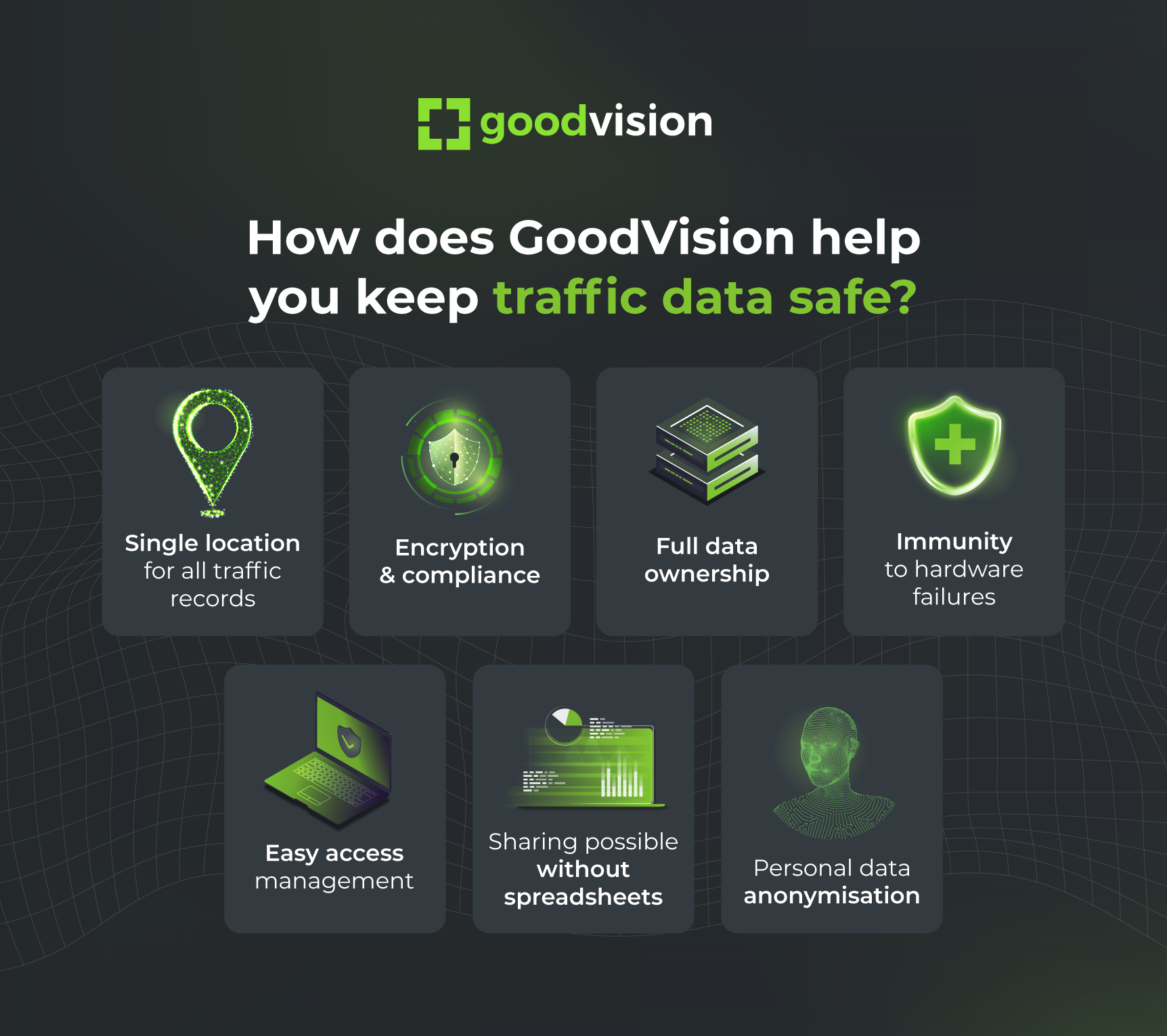Protecting Road Traffic Data: Secure Your Spreadsheets
In 2022, Dallas City reported a severe hit to its police database. Over 20 terabytes worth of photos, videos, audio, notes, and other evidence material were accidentally deleted when a technician attempted to move them to a new City Hall server.
A similar case took place in 2023 in Northern Ireland, where private records—surnames, ranks, department addresses, and more—of all current Police Service officers and civilian staff members leaked and were published online.

Source: Keran News
What these stories have in common, besides entailing massive costs and reputation loss, is that in both, vulnerable records were stored in spreadsheets. Although there’s no denying their usefulness, improperly managed spreadsheets are often the weakest link in companies' information architecture. The same often holds for road traffic organisations.
You must take new protection measures to reap the benefits of spreadsheets in traffic data management without compromising traffic data security. Learn how to protect your traffic data with GoodVision’s traffic analytics platform. Read on!
Who is responsible for data protection in transportation?
For the past decade, governments and states around the globe have been making efforts to regulate the use and protection of data. The results are that dozens of regulations such as GDPR, CPRA, or CDPA companies need to observe in any country where they function and get business.
For this reason, many organisations delegate data compliance-related tasks to a dedicated role within the team. Data controllers, data processors, or even whole dedicated teams working under a CISO (Chief Information Security Officer) are responsible for:
- Establishing and executing security policies.
- Implementing data protection and monitoring measures such as firewalls, encryption, and antivirus software.
- Increasing awareness of potential data security threats and educating their colleagues on how to prevent them.
Like businesses from any other industry, road traffic management and engineering organisations are legally obliged to follow data protection regulations and are held accountable for losing records. In transportation, these sensitive details include personal data that allows for identifying individual road users, such as licence plates.
.jpg?width=759&height=427&name=digital-crime-by-anonymous-hacker%20(1).jpg)
What makes spreadsheets vulnerable?
63% of businesses consider Excel a crucial tool in their everyday operations. This fact alone is the best testament to their usefulness and shows they can be valuable in any industry—including traffic engineering.
That said, spreadsheets have several disadvantages that make them vulnerable or inefficient when protecting and managing records.
Manual updates
To serve as a reliable source of road traffic management data, spreadsheets must constantly be populated with current records. Despite adding new automation features to spreadsheet tools, many organisations continue to update their datasets manually.
This not only takes time but exposes datasets to additional threats. As with all manual processes, there’s the risk of human error when records are replaced, combined, or moved between spreadsheets. Tracking changes and finding who edited the records also becomes more complicated, limiting the ability to maintain the integrity of your road traffic management data and respond to breaches timely.
Messy version control
Although spreadsheets have mechanisms to track changes, as the number of copies and users grows, it becomes increasingly convoluted to trace back who updated which parameter in whose copy of which spreadsheet version.
Multiple copies of the same spreadsheet create confusion and affect data consistency. This may result in costly errors, non-compliance, or, worst of all, copies of records ending up in the wrong hands.
Lack of sharing policies
Once more users gain access to your traffic data spreadsheet, it goes beyond your control. At this point, it may start circulating the organisation, exposing whatever records it contains to risks such as leaks or theft. When a spreadsheet gets shared outside your organisation, it becomes a critical security threat.
Another important factor is how spreadsheets are shared. Organisations use many file-sharing methods to distribute their spreadsheets, including built-in sharing features, on-premise and cloud storage, third-party data services, chats, or even physical formats like hard or flash drives. They all have their benefits and dangers, and with each new sharing method added to your data stack, you open yourself up to new threats.
Exchanging road traffic data via emails makes you even more vulnerableWhen it comes to communication and data sharing, email rules supreme. But is it safe? According to Deloitte, 91% of cyber attacks begin with a phishing email. This means that even if the file transfer is safe, user credentials may be targeted and stolen, granting attackers access to the shared spreadsheets. Worse, phishing isn’t the only way attackers can sneak into your valuable data through email. Other risks include:
Lastly, there’s the human mistake. It’s estimated that 92% of organisations have experienced a data breach caused by end-user error, such as sending an email to the wrong recipient or adding the incorrect attachment. All that makes it crucial for organisations to ensure that their emails are protected, employees are aware of the threats, and that alternative file-sharing methods are implemented where possible. |
How to protect data in transport management?
Despite all these vulnerabilities, spreadsheets remain a simple but extremely efficient tool for compiling and analysing data. So, organisations should focus on making them more secure instead of giving up on using them.
That’s the approach we take. GoodVision Video Insights platform still allows users to generate reports in spreadsheet format, but most of its data management takes place securely within the platform. To improve protection and efficiency further, we combine that with improved traffic data management and centralised record keeping. How do we do it?
Single platform = greater control
First of all, GoodVision keeps all records on a single, cloud-based platform, which offers traffic surveyors and engineers two benefits.
Firstly, road traffic data isn’t scattered across multiple storage spaces. This makes finding specific records easier, controlling your datasets, and implementing safety policies. As for the storage itself, GoodVision uses secure AWS cloud data centres in the client’s region or, if the user requests it, on-premise.
Second, since all data is kept in the cloud, there's no risk of losing it in case of hardware failure. GoodVision Video Insights is integrated with the GoodVision Vault cloud storage, and all platform plans come with 10 gigabytes of space and the option to extend it further. Thanks to that, users don’t have to switch between multiple services—all reports and video recordings are available in one location.
Easy sharing and access management
To resolve the threat of unauthorised data access, the GoodVision platform only allows analytics dashboards to be displayed via the user's private account. No third parties are ever allowed to access these records, and GoodVision never sells them. As a result, users have complete ownership over all data stored there.
Users can view custom-made reports from their accounts for specific timeframes, road sections, movements, traffic participants, and more. They can also share traffic records and reports with authorised co-workers and clients for easy and safe collaboration.
Although GoodVision allows users to export reports as spreadsheets, traffic surveyors and engineers can view them on the platform. This way, data can be retained in the application and doesn’t need to be shared via email (one of the core vulnerabilities in business data security). The one-stop approach also facilitates access tracking, minimising the risk of unauthorised access.
Compliance and anonymisation
GoodVision is fully GDPR-compliant, which guarantees the highest standard of traffic data protection and that privacy policies are strictly defined for users.
All processed data is anonymised, and records allowing identification aren't stored permanently. After the platform extracts data from the footage, videos are forever deleted. Users can keep recordings on their private GoodVision Vault storage upon request. All that helps users make sure that no vulnerable records are leaked.

Fortify your spreadsheets, protect traffic data
The police data breaches demonstrate that even the agencies tasked with protecting public safety aren’t immune to cyber threats. If not properly secured, spreadsheets and emails can be the perfect backdoor for bad agents trying to lay hands on sensitive data.
Fortunately, with GoodVision, you can share, process, and analyse all road traffic data records without worrying about their safety. Reach out to us to learn more about our data protection measures and other features.



